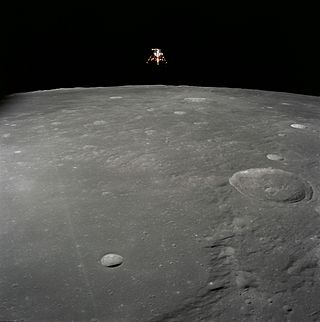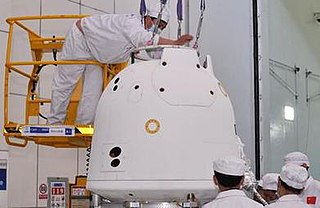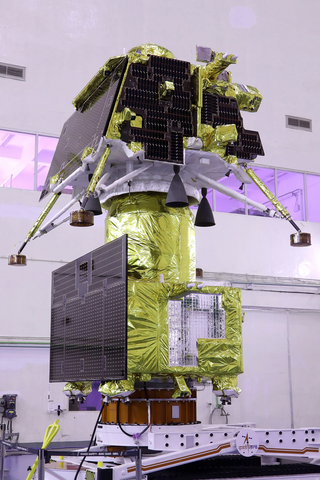Related Research Articles

Apollo 8 was the first crewed spacecraft to leave low Earth orbit and the first human spaceflight to reach the Moon. The crew orbited the Moon ten times without landing, and then departed safely back to Earth. These three astronauts—Frank Borman, James Lovell, and William Anders—were the first humans to witness and photograph the far side of the Moon and an Earthrise.

Apollo 10 was the fourth human spaceflight in the United States' Apollo program and the second to orbit the Moon. NASA, the mission's operator, described it as a "dress rehearsal" for the first Moon landing. It was designated an "F" mission, intended to test all spacecraft components and procedures short of actual descent and landing.

Apollo 12 was the sixth crewed flight in the United States Apollo program and the second to land on the Moon. It was launched on November 14, 1969, by NASA from the Kennedy Space Center, Florida. Commander Charles "Pete" Conrad and Lunar Module Pilot Alan L. Bean performed just over one day and seven hours of lunar surface activity while Command Module Pilot Richard F. Gordon remained in lunar orbit.

The Surveyor program was a NASA program that, from June 1966 through January 1968, sent seven robotic spacecraft to the surface of the Moon. Its primary goal was to demonstrate the feasibility of soft landings on the Moon. The Surveyor craft were the first American spacecraft to achieve soft landing on an extraterrestrial body. The missions called for the craft to travel directly to the Moon on an impact trajectory, a journey that lasted 63 to 65 hours, and ended with a deceleration of just over three minutes to a soft landing.

A trans-lunar injection (TLI) is a propulsive maneuver used to set a spacecraft on a trajectory that will cause it to arrive at the Moon.

The Apollo Lunar Module, originally designated the Lunar Excursion Module (LEM), was the lunar lander spacecraft that was flown between lunar orbit and the Moon's surface during the United States' Apollo program. It was the first crewed spacecraft to operate exclusively in the airless vacuum of space, and remains the only crewed vehicle to land anywhere beyond Earth.

A lander is a spacecraft that descends towards, then comes to rest on the surface of an astronomical body other than Earth. In contrast to an impact probe, which makes a hard landing that damages or destroys the probe upon reaching the surface, a lander makes a soft landing after which the probe remains functional.

A Moon landing or lunar landing is the arrival of a spacecraft on the surface of the Moon. This includes both crewed and robotic missions. The first human-made object to touch the Moon was the Soviet Union's Luna 2, on 13 September 1959.

A lunar lander or Moon lander is a spacecraft designed to land on the surface of the Moon. As of 2023, the Apollo Lunar Module is the only lunar lander to have ever been used in human spaceflight, completing six lunar landings from 1969 to 1972 during the United States' Apollo Program. Several robotic landers have reached the surface, and some have returned samples to Earth.

In orbital mechanics, a free-return trajectory is a trajectory of a spacecraft traveling away from a primary body where gravity due to a secondary body causes the spacecraft to return to the primary body without propulsion.

The physical exploration of the Moon began when Luna 2, a space probe launched by the Soviet Union, made an impact on the surface of the Moon on September 14, 1959. Prior to that the only available means of exploration had been observation from Earth. The invention of the optical telescope brought about the first leap in the quality of lunar observations. Galileo Galilei is generally credited as the first person to use a telescope for astronomical purposes; having made his own telescope in 1609, the mountains and craters on the lunar surface were among his first observations using it.

Manned Venus Flyby was a 1967–1968 NASA proposal to send three astronauts on a flyby mission to Venus in an Apollo-derived spacecraft in 1973–1974, using a gravity assist to shorten the return journey to Earth.

The Lunar Atmosphere and Dust Environment Explorer was a NASA lunar exploration and technology demonstration mission. It was launched on a Minotaur V rocket from the Mid-Atlantic Regional Spaceport on September 7, 2013. During its seven-month mission, LADEE orbited the Moon's equator, using its instruments to study the lunar exosphere and dust in the Moon's vicinity. Instruments included a dust detector, neutral mass spectrometer, and ultraviolet-visible spectrometer, as well as a technology demonstration consisting of a laser communications terminal. The mission ended on April 18, 2014, when the spacecraft's controllers intentionally crashed LADEE into the far side of the Moon, which, later, was determined to be near the eastern rim of Sundman V crater.

In orbital mechanics, a circumlunar trajectory, trans-lunar trajectory or lunar free return is a type of free return trajectory which takes a spacecraft from Earth, around the far side of the Moon, and back to Earth using only gravity once the initial trajectory is set.
Advanced Gemini is a number of proposals that would have extended the Gemini program by the addition of various missions, including crewed low Earth orbit, circumlunar and lunar landing missions. Gemini was the second crewed spaceflight program operated by NASA, and consisted of a two-seat spacecraft capable of maneuvering in orbit, docking with uncrewed spacecraft such as Agena Target Vehicles, and allowing the crew to perform tethered extra-vehicular activities.

A lunar rover or Moon rover is a space exploration vehicle designed to move across the surface of the Moon. The Apollo Program's Lunar Roving Vehicle was driven on the Moon by members of three American crews, Apollo 15, 16, and 17. Other rovers have been partially or fully autonomous robots, such as the Soviet Union's Lunokhods, Chinese Yutus, and the Indian Pragyan. Four countries have had operating rovers on the Moon: the Soviet Union, the United States, China and India.

Chang'e 5-T1 was an experimental robotic spacecraft that was launched to the Moon on 23 October 2014, by the China National Space Administration (CNSA) to conduct atmospheric re-entry tests on the capsule design planned to be used in the Chang'e 5 mission. As part of the Chinese Lunar Exploration Program, Chang'e 5, launched in 2020, was a Moon sample return mission. Like its predecessors, the spacecraft is named after the Chinese Moon goddess Chang'e. The craft consisted of a return vehicle capsule and a service module orbiter.

Chandrayaan-3 is the third mission in the Chandrayaan programme, a series of lunar-exploration missions developed by the Indian Space Research Organisation (ISRO). The mission consists of a lunar lander named Vikram and a lunar rover named Pragyan, similar to those launched aboard Chandrayaan-2 in 2019.
References
- ↑ Godwin, Robert (1999). Apollo 8: The NASA Mission Reports. Burlington, Ontario, Canada: Apogee Books. pp. 21–23. ISBN 1-896522-50-5.
- ↑ "Returns to home Earth: Chandrayaan-3 Propulsion Module moved from Lunar orbit to Earth's orbit". www.isro.gov.in. Retrieved December 4, 2023.